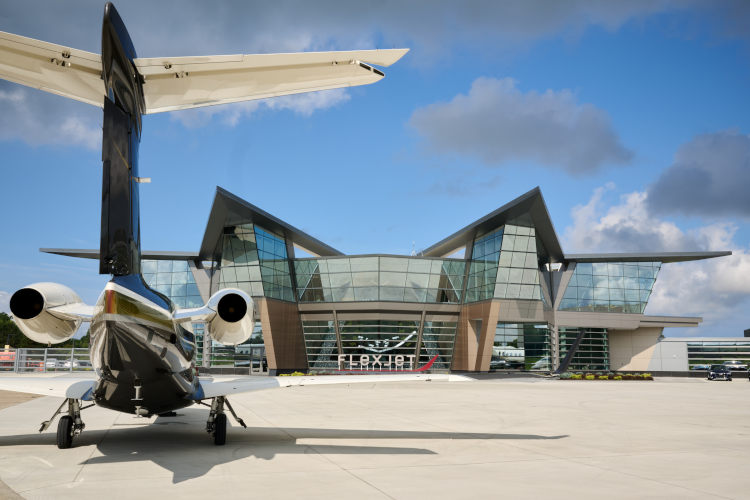The large private aviation provider Flexjet just opened a new, purpose built $50m HQ and Global Operations Control Center. SherpaReport just toured the building and talked to multiple Flexjet staff to learn more about all aspects of their operations.
New HQ Building
The new 51,000 square foot futuristic building is at the Cuyahoga County Airport, about 11 miles east of downtown Cleveland, OH. The airport is the home for Flexjet and the new building increases the company’s local campus size to a total of 243,000 square feet with office space for 670 of the company’s 4,000 employees (who work for Flexjet and its sister companies globally).
Operations Control Center
The literal and eye-drawing middle of the building is occupied by the Global Operations Control Center – a vast open room that is the beating heart for all Flexjets flights. The room is dominated by a gigantic 176 feet wide by 19 feet high LED screen, which is the largest in the U.S. and third largest in the world. The screen displays every Flexjet flight around the world in real-time, providing a continuously updated view of all the fleet operations.
In font of this screen are the operations staff, in stadium style seating, with 137 total seats – 89 of them in tiers and 48 in an upper area.

There are four key groups of operations staff in these seats:
- Flight communications – who work with flight crew members to cover flight dispatch, flight tracking and duty tracking.
- Scheduling – who coordinate and build each day’s schedule 24 hours in advance, with help from some custom optimization software. Scheduling teams are split by aircraft size eg light, mid, supermid , large cabin.
- Maintenance - who handle any issues with the planes.
- Logistics – who coordinate with crews on hotels, ground transport etc.
At the top of the tiers in the center of the room is the “Decision Ring" - shown in the image below. This is a pop-up command station, where representatives from all four groups can gather, for instance during peak travel season (such as the winter holidays) when customer flying is at high volumes and heightened coordination is required.

Overall, the center is designed to accommodate planned growth, with enough room for the staff and technology required to manage double the current fleet of nearly 270 fixed wing aircraft.
Global View
The new operations room is the nerve center for over 30 locations worldwide, across the Flexjet ecosystem. This includes flight tracking for sister operation’s such as FXAir, Sentient and Flexjet Europe. Although the latter two also have their own significant operations control centers.
On the day we visited, while the middle of the large screen showed the locations of Flexjets own aircraft, on the left side was another part of the screen with the Sentient and Flexjet Europe flights.
This overview across all flights enables efficiencies to be identified. “By having eyes on Sentient flights – if we see an empty leg in part of the country – maybe FX Air can use it,” said Jason Christensen Senior Schedule and Charter Manager.
“We did 550 trans-atlantic flights this summer” noted Kenn Ricci, Flexjet's Chairman and added “50% of European flights are flown for US owners.” So clearly the global coordination is key to efficient operations.
Flight Numbers
On a typical day about there are about 200 North American flights with an average flight being about 2.1 to 2.2 hours in length. This means that the four teams above need to oversee and manage all aspects of these flights, including assessing the impacts of weather, runway closures, airspace closures, owners running later than planned, and all the other items that can come up at a moments notice.
On the busiest days, such as the Sunday after Thanksgiving, the number of flights can be double the normal level. And patterns change during the course of the year, for instance in the summer when customers take vacation flights to their summer homes, such as flying to the Hamptons, then the average flight time may drop to 1.6 to 1.7 hours noted Jason Christensen.
One of the most interesting pieces about running hundreds of flights a day, with a fleet of hundreds of planes is that a key part of this puzzle is to optimize the use of the planes. The work of all the teams mentioned above is largely focused on making sure as many flights as possible are carrying fractional owners and fare paying passengers ie that they are revenue generating flights and not re-positioning or empty leg flights. Co-Chief Executive Officer Mike Silvestro told SherpaReport that even at the size and scale of Flextjet, a good occupied rate is about 65% of flights (in other words about 35% are repositioning). This ratio tends to vary a little by cabin size said Mike, with larger planes having higher usage, and the overall range is between 60% and 70%.
Fractional Owners & Customers
Across the Flexjet group, there are about “10,000 guaranteed contracts” said Andrew Collins Co-Chief Executive Officer of Flexjet and CEO of Sentient. This number consists mainlys of Sentient jet card holders and Flexjet fractional jet owners.
For the Flexjet owners their primary touchpoints are with the owner services team, who are also in this new building. There are a few owner services staff on the floor of the control center, but most of them are in offices around the outside of the large central operations room.
Kenn Ricci told SherpaReport that 30% of new owners come and see the operation at Flexjet HQ. And the way this new building is set up, means aircraft can pull up right in front, and as soon as someone steps off the plane they are looking through the glass walled building, straight into the control room, with the massive screen as a backdrop. It’s an impressive sales tool.
For new fractional owners “deliveries are more normalized” said Kenn Ricci, meaning that new aircraft are being delivered months out, rather than years out (as was the case at the peak of covid induced demand). In other words, if you wanted to buy a new fraction today, in September 2023, you could expect delivery in early 2024.
So, there’s still a bit of a waitlist, but Kenn Ricci noted that “we can now provide some level of lift while the owner waits for their tail number to arrive,” but these intermediate flights would not come with the 4-hour guarantee that a fractional owner would have once their aircraft arrives.

Maintenance
It’s notable that as part of its operations Flexjet has been ramping up its in-house maintenance capabilities. Cleveland based Constant Aviation has long been a sister company of Flexjet, and became more tightly integrated earlier this year. Then just last month, Flexjet bought Flying Colours, a large aviation maintenance, repair and overhaul (MRO) provider. At the time of the acquisition Kenn Ricci noted “Flexjet now fully controls its maintenance and product support needs.” The expanded maintenance offering includes 12 primary facilities and 30 geographically dispersed Aircraft on Ground (AOG) response teams to provide field support to the Flexjet fleet.
Farnborough Service Training
Flexjet has also recently opened a service training academy in Farnborough, UK, - called The Red Label Academy - where it will be training all its cabin servers over the next year. The training is in-house, with specialists such as sommeliers and private dining experts brought in to share their expertise. The company has also partnered with the renowned Dorchester Hotel in London, and all the staff spend a night at the hotel and get to see how it operates behind the scenes.
Megan Wolf, Chief Experience Officer, Flexjet explained that all new cabin server hires will spend two weeks training and existing cabin staff will be at the academy for 7 days of training.
In creating the academy, the company has built a mock fuselage, so the cabin crews can practice in a realistic environment with the correct dimensions.
Staff are given wide ranging training and encouraged to be inventive and take initiatives, say Megan Wolf. This can include buying locally sourced fresh items, encouraging them to be creative, and being able to tell the story of where the items were sourced from, so that they can even surprise Flexjet owners with some of the more interesting elements. And, as in all great restaurants, the staff are trained in the presentation of items, with training also covering specific skills to cater to children and pets onboard flights.
To enhance this training, Megan explained that the 130 cabin servers, may spend some time flying in North America or in Europe giving them a broader view and more experience. But it’s not just the cabin servers who go to the academy, the staff at Flexjets private terminals also go to Farnborough for service training.
Mike Silvestro, co-CEO of Flexjet explained that the aim is to create the experience of being in a high-end European restaurant and be able to delight and potentially surprise customers. The company has hired Francesco Vanerio from Villa dEste on Lake Como to emphasize the art of service in designing the in-flight experience.
The cabin servers are standard on the Flexjet Global, Gulfstream 450, and Gulfstream 650 aircraft. In Europe they are also standard on the Praetor 600.
Flexjet likes to say “You won't just be flown, you'll be moved” and their new Operations Center is certainly designed to cause a stir.

